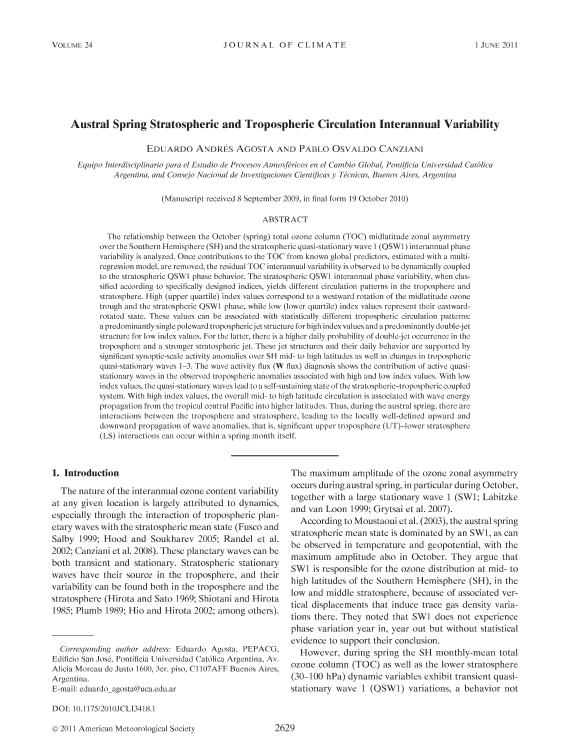Artículo
Austral spring stratospheric and tropospheric circulation interannual variability
Fecha de publicación:
06/2011
Editorial:
Amer Meteorological Soc
Revista:
Journal Of Climate
ISSN:
0894-8755
Idioma:
Inglés
Tipo de recurso:
Artículo publicado
Clasificación temática:
Resumen
The relationship between the October (spring) total ozone column (TOC) midlatitude zonal asymmetry over the Southern Hemisphere (SH) and the stratospheric quasi-stationary wave 1 (QSW1) interannual phase variability is analyzed. Once contributions to the TOC from known global predictors, estimated with a multiregressionmodel, are removed, the residual TOC interannual variability is observed to be dynamically coupled to the stratospheric QSW1 phase behavior. The stratospheric QSW1 interannual phase variability, when classified according to specifically designed indices, yields different circulation patterns in the troposphere and stratosphere. High (upper quartile) index values correspond to a westward rotation of the midlatitude ozone trough and the stratospheric QSW1 phase, while low (lower quartile) index values represent their eastwardrotated state. These values can be associated with statistically different tropospheric circulation patterns: a predominantly single poleward tropospheric jet structure for high index values and a predominantly double-jet structure for low index values. For the latter, there is a higher daily probability of double-jet occurrence in the troposphere and a stronger stratospheric jet. These jet structures and their daily behavior are supported by significant synoptic-scale activity anomalies over SH mid- to high latitudes as well as changes in tropospheric quasi-stationary waves 1-3. The wave activity flux (W flux) diagnosis shows the contribution of active quasistationary waves in the observed tropospheric anomalies associated with high and low index values. With low index values, the quasi-stationary waves lead to a self-sustaining state of the stratospheric-tropospheric coupled system.With high index values, the overall mid- to high latitude circulation is associated with wave energy propagation from the tropical central Pacific into higher latitudes. Thus, during the austral spring, there are interactions between the troposphere and stratosphere, leading to the locally well-defined upward and downward propagation of wave anomalies, that is, significant upper troposphere (UT)-lower stratosphere (LS) interactions can occur within a spring month itself.
Archivos asociados
Licencia
Identificadores
Colecciones
Articulos(SEDE CENTRAL)
Articulos de SEDE CENTRAL
Articulos de SEDE CENTRAL
Citación
Agosta Scarel, Eduardo Andres; Canziani, Pablo Osvaldo; Austral spring stratospheric and tropospheric circulation interannual variability; Amer Meteorological Soc; Journal Of Climate; 24; 11; 6-2011; 2629-2647
Compartir
Altmétricas




